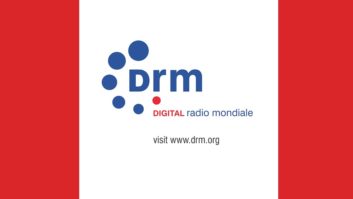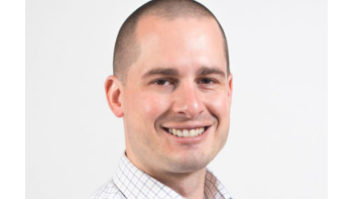The Federal Communications Commission has been hearing from the National Association of Broadcasters and other interested parties about whether to allow AM band stations to turn on all-digital transmission, and under what parameters.
In addition to publicly filed comments, the NAB, which supports the idea, has made presentations to FCC staff about certain specifics — including whether the FCC should allow Digital Radio Mondiale to be tested in this country. NAB says it should not.
Background
It was in November 2019 that the commission announced its proposal to allow AM stations to broadcast an all-digital signal using the HD in-band on-channel (IBOC) mode known as MA3. This came after a petition from Bryan Broadcasting.
As part of its Notice of Proposed Rulemaking, the FCC concluded that a voluntary transition to all-digital broadcasting has the potential to benefit AM stations as well as provide improved AM service to the public.
The commission then asked for comment on proposed operating standards and the impact on existing analog stations and listeners. We’ve reported on many of the comments it received.
FCC Audio Division Chief Al Shuldiner told Radio World in September, “Commenters in that proceeding expressed strong industry support for the commission’s proposals to allow AM stations to convert to all-digital operation and we hope to move forward in that proceeding by the end of the year.”
Focusing on specifics, NAB representatives spoke in early September with members of the FCC Media Bureau’s Audio Division about the proposed transition, according to an ex parte filing.
David Layer, NAB’s vice president of advanced engineering, gave technical input on four specific topics: operating rules on power limits, all-digital AM RF mask requirements, potential interference issues, and proposed frequency tolerance standards.
He expressed NAB support for using average power measurements for establishing station operating power for all-digital service. He said this is the method that has been used in the NAB’s PILOT testing as well as by Hubbard station WWFD(AM), which operates under experimental authority.
Layer cited coverage maps created by PILOT and WWFD that showed that these stations have sufficient all-digital coverage without causing objectionable interference.
He also urged the commission not to impose a 1 Hz frequency tolerance on all AM stations, but agreed that it may be appropriate to impose this tolerance on all-digital AM stations. The NAB supports the use of all-digital AM RF masks as proposed by HD Radio parent company Xperi.
Allow Digital Radio Mondiale
Meanwhile another issue raised NAB’s concerns.
In June the DRM Consortium participated in a conference call with members of the FCC Media Bureau’s Audio Division to tell them about DRM’s role as a “superior, flexible and advanced technology solution,” according to Ruxandra Obreja, chair of the DRM Consortium, in a followup letter to the commission.
DRM should have the opportunity to be tested for U.S. domestic use in the AM bands, Obreja argued.
[Read a commentary by Obreja: “Can Digital Radio Standards Coexist?”]
“Such a test would allow for a proper comparison with HD in all-digital AM broadcast and open the possibility of including DRM, either alone or together with HD in the proposed regulation, as a full-digital transmission standard for the AM bands — with the option for simulcast operation alongside analog AM signals from the same transmitter if required,” Obreja said.
“This would also answer the question on the benefits and its attractiveness when compared to and introduced alongside HD Radio.”
She highlighted DRM’s spectral efficiency; its ability to carry multiple audio services including text, emergency warning information and metadata within a 10 kHz signal bandwidth; and its capability to transmit parallel channels in different languages.
DRM also described the benefits of having a receiver able to receive both DRM and HD Radio, as well as analog AM and FM transmissions for the transition period.
“[The] USA would not be the only country in the world envisaging the use of more than one digital radio standard,” Obreja said. “The technical solutions exist; for the listener what matters is that they can listen to all the digital broadcasts available in their country through a common user interface.”
Noting that AM in the U.S. covers large rural areas, she said the fast development of in-car adaptors for DRM would offer easy access to digital radio for owners of legacy cars with only analog AM or HD Radio reception. Letting AM stations have access to both DRM and HD Radio services could provide significant benefits to those broadcasters.
Don’t allow DRM
The NAB had a sharp response to the DRM Consortium’s request, calling it ill-advised and contrary to the FCC’s intent.
The NAB said the commission already selected HD Radio IBOC as the exclusive digital technology approved for AM radio, and that making a change now be extremely disruptive.
“Although HD Radio is a mature and proven technology, there will be important considerations that will enter into a broadcaster’s decision to transition such as the equipment costs to convert, the potential loss of listeners who do not obtain an HD Radio receiver, and perhaps most importantly, regulatory certainty,” wrote NAB Associate General Counsel Larry Walke in a letter to the commission.
“Before pulling the trigger on such a fundamental change to one’s operation, AM broadcasters need every confidence that HD Radio technology will remain the exclusive technical solution for all-digital transmission.”
Any moves to test or otherwise consider DRM as an alternative technology would undercut such confidence, discourage greater adoption of HD Radio and jeopardize the viability of all-digital AM, Walke said, adding that consideration of a second digital radio technology at this juncture could only be harmful to transitions by AM stations.
Regulatory certainty is vital, Walke concluded, and the FCC’s goals to revitalize AM radio can only be furthered if it stays the course.
The NAB urged the commission to wrap up the deal by finally incorporating the NRSC-5 in-band/on-channel Digital Radio System standard into its rules. “This will make it clear that [this] is one and only digital radio system approved for use in the U.S.,” Walke said.
Other public comments on all-digital for AM can be found in the FCC’s ECFS database using Media Bureau docket numbers 19-311 and 13-249.
Related:
Small-Market Owners Caution Against “AM Stereo Situation”
NPR Supports All-Digital, With Caveats
Xperi Urges FCC to Allow All-Digital on AM












